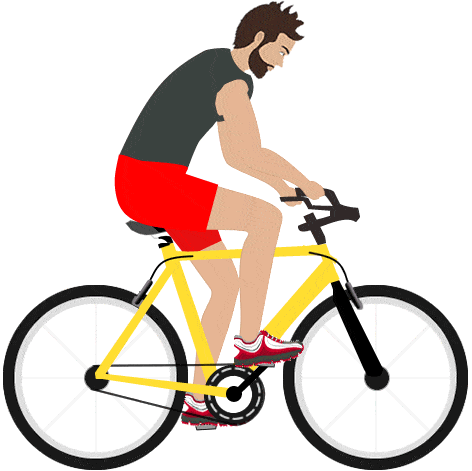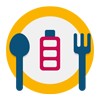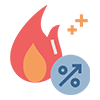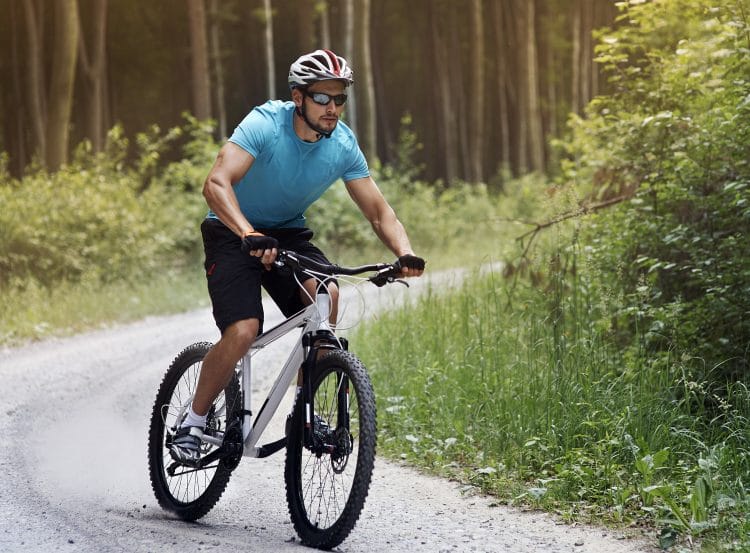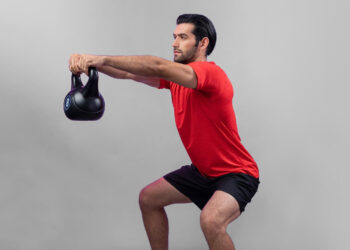Biking burns approximately 250-300 calories per hour for easy-to-moderate cycling, such as commuting. For more vigorous cycling, this number can increase to 600 calories per hour, and professional racing can burn 1,000 or more calories per hour.
:
HoursCalories Burned with Outdoor Activities (weight: 175 lbs)
| MET | 15 mins. | 30 mins. | 45 mins. | 60 mins. | |
|---|---|---|---|---|---|
| Cycling or Biking | 9 | 188 | 375 | 563 | 750 |
| Hiking | 4.8 | 100 | 200 | 300 | 400 |
| Fishing | 3.5 | 73 | 146 | 219 | 292 |
| Horseback Riding | 5.5 | 115 | 229 | 344 | 458 |
| Kayaking | 5 | 104 | 208 | 313 | 417 |
| Skating | 9 | 188 | 375 | 563 | 750 |
| Skateboarding | 5 | 104 | 208 | 313 | 417 |
| Golf | 4.8 | 100 | 200 | 300 | 400 |
| Jogging | 9.8 | 204 | 408 | 613 | 817 |
| Rock Climbing | 8 | 167 | 333 | 500 | 667 |
The bicycle plays an important role in our society, especially as a popular transportation alternative. But there are so many other uses for one including fun, adventure, sport, and not to mention, it’s one of the best exercise tools ever.
The low-impact nature of pedaling to propel a bike forward makes it perfect for pretty much anyone, and they’re relatively affordable. Although, as with anything else, there are different price tiers (you get what you pay for).
Anyhow, let’s talk about our cool new calories burned cycling calculator.
How Does It Work?
The calories burned biking tool estimates energy expenditure during cycling activities.
But why does one need to know this information? There are a few reasons.
Level Up Your Fitness: Join our 💪 strong community in Fitness Volt Newsletter. Get daily inspiration, expert-backed workouts, nutrition tips, the latest in strength sports, and the support you need to reach your goals. Subscribe for free!
Whether you’re trying to lose weight, maintain your weight, or even gain weight, you must have a somewhat of idea of how many calories you’re taking in.
Sure, anyone can lose weight by not eating much and burning calories from cycling. Is it safe and sustainable? Most likely not. The same goes for someone who’s trying to gain weight or bulk up. You could just eat a bunch of junk calories to ensure you’re not in an energy deficit, but that could lead to lots of fat gain and compromised health.
That’s why if you have a specific body goal, it’s important to implement some strategy and we’ll talk more about this shortly.
The calories burned biking calculator uses a formula to approximate calories burned based on the following factors.
Bodyweight
A calorie is a unit of energy and a heavier person requires more energy to move their body compared to someone who weighs less.
Think of it like how a larger vehicle typically uses up more fuel than a smaller one. Weight affects fuel consumption (the amount of energy used).
But this also means that the heavier person expends more calories when they’re sedentary or in a rested (non-active) state.
This is also known as metabolic rate or metabolism.
Speed
The faster you pedal, the more distance you will cover and the more calories you are going to burn in the same duration compared to if you pedal at a slower pace.
Time and Distance traveled
While intensity/speed can ramp up calories burned, the farther you travel and the longer you cycle, the more calories you will burn.
You can actually achieve your calories burned goal through either speed and intensity or distance. It really just depends on your desired outcome.
How To Use The Calculator
The calories burned biking calculator is rather simple, and straightforward.
To ensure an easy experience for you, we’ve included step-by-step instructions in detail below.
Step 1: Choose your preferred unit of measurement: Imperial (lbs, hours, and minutes) or metric (kilograms, hours, and minutes).
Step 2: Enter your weight.
Step 3: Type in the biking time in hours and minutes. Note: If hours only, put a “0” in the ‘minutes’ box. If minutes only, put a “0” in the ‘hours’ box.
Step 4: Enter the distance in miles traveled.
Note: If you do not know the distance, select your “Biking speed” and it will estimate the distance traveled. Otherwise, “Biking speed” is determined by inputting the biking time and distance.
Step 5: Press Calculate!
How Many Calories Can I Burn Biking or Cycling?
The number of calories that you can burn from activity depends on a few different factors such as your weight, exercise intensity, and duration, or how long you perform the activity. Therefore, this can highly vary.
But this calculator does most of the guesswork. You punch in the necessary details and it’ll give you a close estimate of calories burned biking.
However, we’ve provided examples of how our calculator will estimate calories burned.
According to the calories burned biking tool, a 200 lb person who rides for an hour and travels 10 miles will burn 648 calories.
For a 150 lb person who bikes for an hour and a half for a distance of 25 miles, they’ll have burned around 1286 calories.
If this same person bikes a mile in 5 minutes at 12 mph, they’ll have expended only 48 calories.
How many calories you can burn biking or doing any physical activity is dependent on several factors.
Level Up Your Fitness: Join our 💪 strong community in Fitness Volt Newsletter. Get daily inspiration, expert-backed workouts, nutrition tips, the latest in strength sports, and the support you need to reach your goals. Subscribe for free!
While it’s not so easy to precisely estimate calories burned from movement, our calculator is designed to provide a reasonable estimate of energy expenditure.
Can Biking Help Me To Lose A Lot of Weight?
Biking can be a very challenging activity and as a result, it can help to burn lots of calories which is an essential component of the weight loss process.
But how much weight you lose really and truly depends on your overall habits and approach to your goals.
As long as you create a calorie deficit, and do it the healthy and proper way, you can lose weight.
If you’re biking and/or doing other forms of physical activity in an effort to lose weight, you want to determine your Maintenance calories/TDEE, and then reduce your calorie intake, exercise more, or do a combination of the two.
Use our weight loss calculator to determine the number of calories you should be consuming if your goal is to burn off pounds.
If you also do resistance training and want to maximize muscle gain and muscle maintenance as you knock off the body fat, our macronutrient calculator is a very useful tool.
It’ll recommend an ideal protein, carbohydrates, and fat intake for you.
How Many Calories Does Biking Burn Compared To Other Forms of Cardio?
There are many different variables that determine the number of calories burned between the different forms of cardio activity. Weight, intensity/pace, and duration are the biggest factors. Although, environment/weather, hormones, and genetics also play a role too. But there are no simple ways to measure these.
Therefore, we stick with the basic details that contribute most to the estimation.
If you’d like to compare estimates of calories burned during various activities, we offer a free calculator that includes a database of over 250 different exercises and activities.
Is Biking/Cycling A Good Activity For Overweight People?
Let us preface this section by saying that the term overweight applies to people who have both high and low body fat.
That’s because even if someone has a healthy body fat percentage, they may have a naturally bigger build/frame and/or more muscle mass than someone else of the same weight but who has more body fat.
But they would still be considered overweight according to body mass index (BMI) calculations.
Biking is a great option for those who are overweight because it’s very low-impact, unlike running and jogging. These activities can be a lot on the joints especially for heavier individuals.
But while anyone can go biking to burn calories, improve their health and fitness, enjoy the outdoors, or all of the above, as with any form of exercise, it’s important to know your capabilities.
If you’ve never gone biking, are just starting out, and/or are out of shape and carry extra body fat, it’s probably a good idea to start small and do shorter distances.
On the other hand, someone who is in great shape can bike for longer distances.
What Form Of Biking Burns The Most Calories?
Again, many factors determine calories burned during any activity.
However, different forms of biking and the environment/weather can have a significant impact.
For example, trail, BMX, racing, etc require more total body involvement, and therefore, you’ll burn through calories much faster compared to if you were riding at the same speed on a flat surface.
Riding a stationary bike indoors in air conditioning won’t burn as many calories compared to if you rode in the hot sun or outdoors, in general, for the same duration and speed.
The bike weight can also affect energy expenditure as a lighter bike is easier to pedal.
There are just so many different variables.
Uphill and Downhill Cycling
Whether you bike uphill, downhill, or both, it does matter when determining calories burned. The steeper the incline, the more effort you’ll have to put forth to climb that upward angle. Consequently, you’ll use more energy.
However, going downhill may require little to no effort as the downward slope and gravity will do most or all of the work. You’ll therefore burn fewer calories in comparison to pedaling uphill.
This variable fits the activity intensity category.
But it’s important to note that the calculator does not consider whether someone cycles uphill or downhill. In this case, a heart rate monitor may be the best option for estimating calories burned most accurately.
Other calorie calculators
Also be sure to try out our other calorie-based calculators below.
- Body Mass Index (BMI) Calculator
- Basal Metabolic Rate (BMR) Calculator
- Calories burned during over 250 activities
Biking is A Perfect Calorie Burner
Again, we don’t know what your goals are. However, we do know that biking is one of the best ways to burn calories. So if you want to lose weight, we recommend this form of low-impact activity.
But if you do it for fun or use a bike to commute, you may also want to have an idea of how much energy you’re expending.

